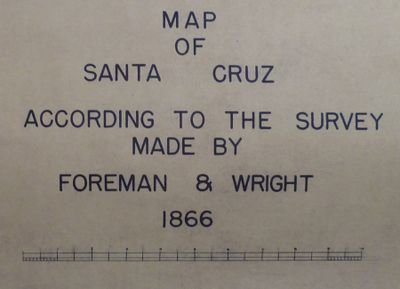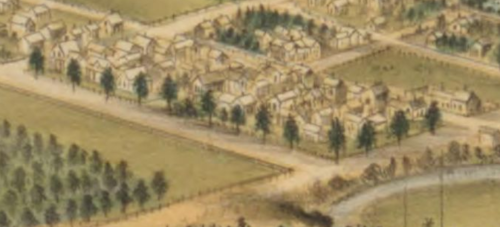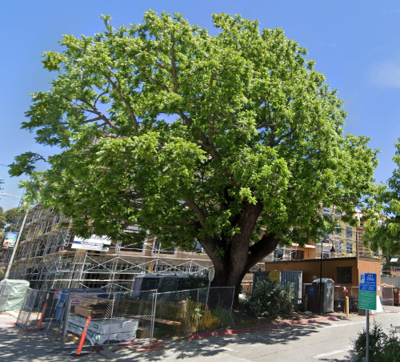History Pages: 24 - The Map and the Trees
For a table of contents, see History pages.
The new Town of Santa Cruz Board of Trustees got busy soon after getting organized in 1866. One of their first actions was to commission a map of the growing town. The job went to Solomon Foreman, a local civil engineer, and Thomas Wright, the elected County Surveyor. Wright had already created many maps for local landowners, but the Foreman & Wright map of 1866 was the first with a civic purpose. The image at right is a detail from the map's front page.
Along with creation of the map, many streets were given official names for the first time (see note 1), and others had their names changed. The two most important name changes were: Willow Street became Pacific Avenue, and Main Street became Front Street (the discontiguous section of Main Street on Beach Hill kept its name). The Pacific Avenue change may have had a connection to the grand new Pacific Ocean House Hotel (see 21 - The Town). Or maybe the Trustees decided that the street which had surpassed Main Street as the primary conduit of downtown commerce needed a more powerful name - from the humble Willow to the mighty Pacific. Whatever the reasons, the change obscured some local history and began a trend away from naming Santa Cruz streets after local native trees and other useful plants.
Willow Street had been so-named because the mission padres planted a row (one source says a double row) of willow trees marking the edge of their cultivated fields. The trees were spaced at ten-foot intervals, and strips of leather were tied between them, serving as a crude fence intended maybe to keep stray livestock out of the fields. As the only road running from downtown to the bay, Willow Street became more important as shipping traffic increased during the 1850s. Smaller lots were created along both sides of the street, which began to be filled with commercial and residential buildings. By 1861, most of the willow trees had been cut down, their original function no longer necessary.
The southeast corner of the cultivated mission land was near today's corner of Pacific Ave. and Laurel St. In the detail at left from an 1870 "bird's eye" view of Santa Cruz, thirteen large, evenly spaced trees can be seen at the edge of the roadway, rounding the inside of that corner. It seems plausible that those are the last of the old mission willows.
Did anyone lament the loss of this tribute to one of the most common yet important local trees? Apparently not, for no Santa Cruz street is named Willow today. In fact, of all the downtown streets named after trees, very few are local species. Neither have the iconic Monterey trees earned any recognition downtown. You'll have to head out to the Eastside neighborhood to find Cypress Avenue and Pine Street.
The transplanted north-easterners, who by 1866 formed the core of the downtown business community, were perhaps a bit homesick and chose to name streets mostly after eastern trees. Take a hike in the area and you’ll search in vain for a native Cedar, Locust, Elm, Chestnut or Myrtle. I'll give them a pass on Spruce, since our Douglas Fir was often called a spruce back in those days.
Walnut, Maple and Sycamore are better choices. Native varieties of those trees grow both locally and in the northeast. Walk along the San Lorenzo River north of the levees and you’ll find both maples and sycamores, along with alder, cottonwood, oak, buckeye and - of course - willow.
One of the two most venerable downtown trees is a walnut, but not a native. It's the ~150-year-old Black Walnut (right) in the parking lot at the head of Cedar Street. Equally ancient is the giant and incongruous Southern Magnolia on Church Street, between Cedar and Center. Both trees were planted as landscaping: the Black Walnut in the gardens behind the Pacific Ocean House hotel, and the magnolia in the yard of Samuel Drennan.
I’m suspicious of Laurel Street - although our local bay tree is a type of laurel, I doubt that it was known as a laurel in 1866. Several species of laurel are, however, very common in the northeast, where they contribute to the famous fall colors. We could pretend that Bay Street was named for our local tree rather than the body of water, but no. Special recognition goes to UCSC for the Bay Tree Bookstore, even though it's not downtown. Even the mighty redwood gets snubbed. Instead we have the generic Evergreen Street and cemetery over in the Harvey West area.
When I take a walk downtown, I’d like to see more signs that are reminders of the native trees and other plants that contributed to the mid-19th-century growth of the Santa Cruz region (not to mention earlier Ohlone communities). Our town is surrounded by forests of redwood, oak, madrone, fir and pine that provided lumber for building, fuel for the lime kilns and charcoal for the Powder Company. The tanbark oak was essential for tanning leather. Hazel, willow and alder were all used for barrel hoops in the construction of wooden barrels for lime and other export products. And, of course, the leaves of the bay tree contribute to the flavor of our native Italian cuisine ;-). On the other hand, to be fair, there’s no reason why the 1866 Board of Trustees should have felt compelled to consider my arguments when they chose street names. Our downtown “tree streets” are instead a reminder that a substantial group of ambitious and energetic people native to the eastern states relocated to Santa Cruz and were active in their 1860s community.
Notes
- “Map of the Town of Santa Cruz”, Santa Cruz Sentinel, Jun 23, 1866, 2:4. One other major street name change: Main became Front. Many other streets got names for the first time: River, Potrero (the northern half is now Evergreen), High, Water, Mission, Union, Green, Cross, and Rincon. The map also showed property boundaries and owner names. The Sentinel article included a list of those names.


